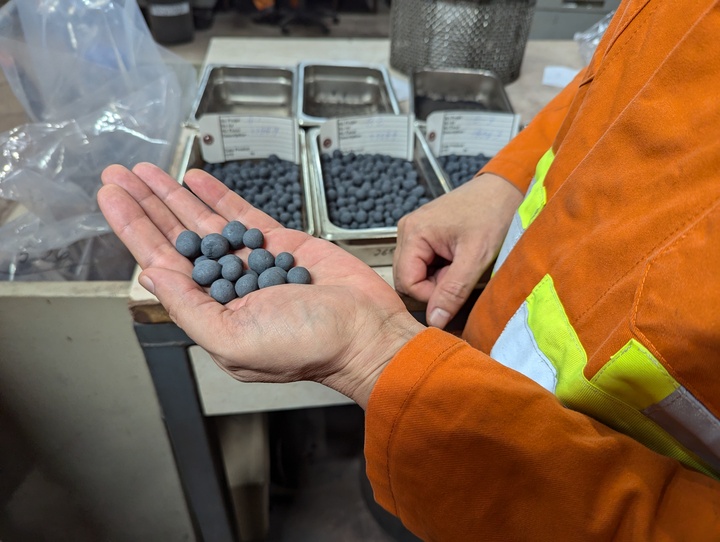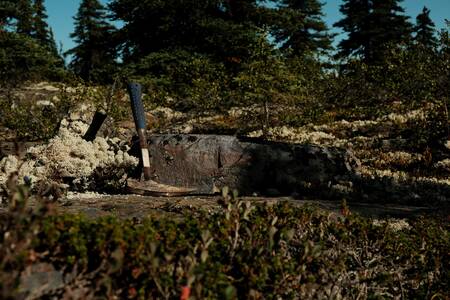The steelmaking expertise behind Cyclone Metals has fast-tracked the company to assert its position as the first ASX-listed junior to produce premium iron ore pellets for low-carbon steel.
The company recently completed a pilot direct reduction (DR) pellet production run, using ore from its 100%-owned Iron Bear project in Canada's Labrador Trough.
The result was DR pellets with world-class specifications and excellent physical properties, ideal for the forecast demand in the increasingly environmentally-aware steel sector.
Cyclone CEO Paul Berend highlighted the importance of this achievement.
"There isn't a single junior in Australia who's ever produced DR pellets before and there are only three substantial producers of DR pellets – in the world," he explained.
The company is now starting small-scale industrial production, aiming to ship bulk samples of Iron Bear product to potential offtake clients in the first half of 2025.
 Cyclone Metals tested four different chemistries to perfect its DR pellets from Iron Bear | Credits: Cyclone Metals
Cyclone Metals tested four different chemistries to perfect its DR pellets from Iron Bear | Credits: Cyclone Metals Why DR pellets?
The company has taken an atypical approach to most juniors to reach this exciting juncture.
Thanks to the steel industry experience brought by Paul Berend and Paul Vermeulen – a metallurgical engineer and Cyclone's general manager technical and steel markets – the pair began by asking what steelmakers needed.
The answer was DR pellets, a market expected to double by 2035 thanks to the environmental benefits they offer to steelmakers looking to reduce their carbon footprint or produce "green" steel.
Regulations including Europe's Carbon Border Adjustment Mechanism (CBAM) are expected to increase the cost of producing steel using traditional coal-fired blast furnaces.
High-quality DR pellets are the required feed for direct reduction iron electric arc furnaces (DRI-EAF), which use natural gas or hydrogen as a reductant.
"Green" steel is produced when renewable hydrogen is used instead of natural gas.
"DRI units typically have half the carbon footprint of blast furnaces so that technology is growing and the market for DR pellets is going through the roof," Berend said.
Industry analysis showed global production of DRI-EAF steel of 136 million tonnes in 2023, with a further 100Mt capacity expected to come online by 2030.
This would require an additional 148Mt of DR pellets by 2030, representing a huge opportunity for Iron Bear, Berend said.
DR pellets also deliver a price premium, circa US$63/t above the benchmark 62% Fe iron ore price, which is sitting around $100 per tonne.
Berend said the standard industry pelletising conversion cost was about $15/t, which implied a typical additional cash profit of about $48/t for DR pellets versus benchmark iron ore.
Berend was earlier general manager business development for Rio Tinto's iron ore division, GM corporate strategy for steel major ArcelorMittal, Director Australasia at Hatch and has worked at consultancies including McKinsey and Company and Partners in Performance.
Vermeulen's experience includes managing one of the largest blast furnaces in the southern hemisphere for Iscor South Africa and a marketing role at Rio Tinto Iron Ore, before establishing an iron ore consultancy in 2007.
 Cyclone Metals' Iron Bear project in Canada has a 16.6Bt resource | Credits: Cyclone Metals
Cyclone Metals' Iron Bear project in Canada has a 16.6Bt resource | Credits: Cyclone Metals Iron Bear's attributes
With DR pellets in mind, Cyclone Metals acquired the Iron Bear project in Labrador and Newfoundland, already considered one of the world's largest undeveloped magnetite deposits.
Within two years, Cyclone has updated the resource to 16.6 billion tonnes at 29.2% iron and commissioned an industrial pilot plant to demonstrate Iron Bear can produce high-quality magnetite products thanks to its ultra-low deleterious elements.
Iron Bear sits in the iron ore-rich Labrador Trough, home to operations owned by Tata Steel, Champion Iron and Rio Tinto's Iron Ore Company of Canada.
Berend said Iron Bear was a huge mineral resource – but simple, with a low stripping ratio and a relatively low mining cost.
It also benefits from access to infrastructure.
It's close to low-cost hydropower from Menihek, and within 25km of an open access heavy haulage railway which runs directly to the open access Pointe Noir Port iron ore export facility, designed to cater to Capesize vessels.
Lessons in chemistry
"If you look at Iron Bear's mineral resource itself, the iron content is typical for a magnetite deposit," Vermeulen said.
"But what is remarkable is the extremely low levels of all the deleterious metals, like manganese or chrome.
"That is extremely unique."
Cyclone had earlier produced DR-grade concentrate from Iron Bear, grading 71.3% iron and 1.1% silica.
The latest test work tried out four different DR pellet chemistries to achieve the best outcome.
The result was DR pellets grading 67.5% iron, 1.6% silica, 0.12% magnesium oxide, 0.65% calcium oxide and ultra-low deleterious elements.
Cyclone's DR pellets also passed physical tests with flying colours.
DR pellets need to withstand the tough conditions in a DRI unit, needing a Cold Compression Strength of at least 230kg/pellet.
Iron Bear's DR pellets showed a "class-leading" CCS of 486-438kg/pellet.
Metallisation tests to demonstrate whether the fired pellets would convert to iron in a DR unit revealed an outstanding ratio of 99.1%.
Vermeulen is looking forward to the looming real-world tests for the DR pellets.
"Not only do we get the laboratory test results that show the pellets are good … the proof is in the pudding," he said.
Vermeulen said as well as preparing pellet samples for potential customers, it was also going to run its pellets through the two main DRI technologies – Midrex and Energiron.
The Energiron unit could be run on various gases, allowing traditional steelworks to use excess gas for DRI production – provided they used DR pellets.
"That's a big target market for us," he said.
"It's a real opportunity for European steel mills to remain competitive."
 Cyclone Metals' general manager technical and steel markets Paul Vermeulen | Credits: Cyclone Metals
Cyclone Metals' general manager technical and steel markets Paul Vermeulen | Credits: Cyclone Metals No substitute
Cyclone Metals is in the enviable position where it can investigate Iron Bear's direct shipping ore potential, produce a magnetite concentrate, or blast furnace pellets – or focus on the premium DR pellet market.
For Berend, the market demand, price premium and environmental benefits make DR pellets the obvious choice.
"The prize for us, and for the transformation of the global steel industry, is DR pellets," he said.
"Steel making is responsible for about 8% of all the carbon emissions of humanity – that's truly substantial.
"The whole move to green steel manufacturing with direct reduction and electric arc furnaces is great, but where are the raw materials going to come from?
"There are not enough pellet projects in the world.
"And there is no substitute for DR pellets."
Steel makers have very specific requirements and there are currently only three main DR pellet producers, namely Brazil's Vale, the Iron Ore Company of Canada and Samarco, the BHP/Vale joint venture.
Cyclone Metals has leveraged its expertise to attract industry attention as it moves towards offtake partnerships, further derisk Iron Bear and attract a tier one partner to develop the large-scale project.
"We're the only junior in the world who can provide samples of DR pellets and bulk samples of DR pellets and various concentrates to steel mills," Berend said.
"We know steel mills … they want to see the product to believe it.
"We're taking a different path to other juniors, focusing on product rather than resource.
"We're always aiming to get into production – once we understood what product was needed on the market, we looked for a resource with the right characteristics to make DR pellets.
"We think this is the future."